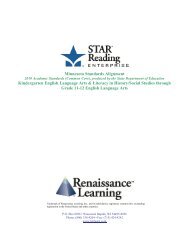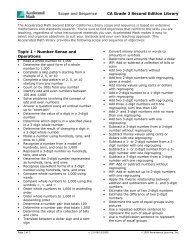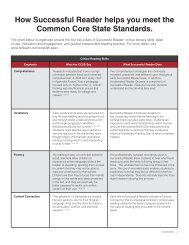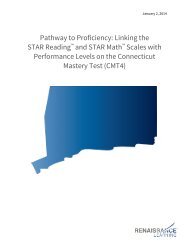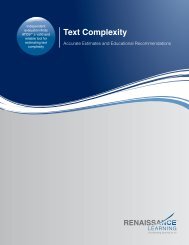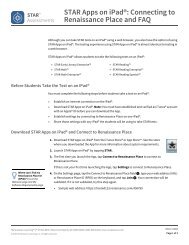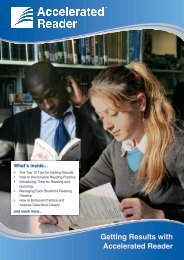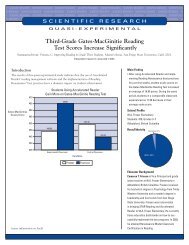Technical Manual - Renaissance Learning
Technical Manual - Renaissance Learning
Technical Manual - Renaissance Learning
Create successful ePaper yourself
Turn your PDF publications into a flip-book with our unique Google optimized e-Paper software.
STAR Early Literacy Enterprise in the ClassroomApproaches and Rationales for Recommended UsesSTAR Early Literacy Enterprise is appropriate for progress monitoring because ittypically takes 10 minutes or less to administer, it can be administered frequently,the results of the assessment can be graphed to show growth, and the assessmentcomprises educationally relevant skills. The guidelines in this section will helpteachers establish appropriate end-of-year goals and the intermediate growthtargets needed to achieve these goals.The Scaled Score is the most appropriate measurement to use for progressmonitoring. This score ranges from 300 to 900 and represents an overview of astudent’s literacy status because it comprises the results of adaptive assessmentin the sub-domains covered by STAR Early Literacy Enterprise.Periodic ImprovementData from the STAR Early Literacy Enterprise Validation Study make it possible toestimate the progress students should make on a monthly and annual basis. It isimportant to keep in mind that changes in Scaled Scores vary from grade-to-gradeand from one achievement level to another. Generally speaking, younger studentswill probably make larger gains than older students because their literacy status ischanging so quickly. The same is true of students who are at lower achievementlevels when compared to those who are at higher achievement levels.These differential changes are not unique to STAR Early Literacy Enterprise, butare typical of virtually all assessments, both formal and informal.Table59 shows the monthly gains that will move students from their currentpercentile to a somewhat higher percentile in the subsequent grade. For example,students in the 25th percentile in first grade will end up in a higher percentile inthe second grade if their monthly score on STAR Early Literacy Enterpriseincreases on average by 1.5 percent. The percentages in the table are estimates,and meaningful variations can exist among students.Table 59:Monthly Scaled Score Percentage Increases by GradeGrade K 1 2 3Lower-achieving students (25th percentile) 4.5 1.5 1.0 1.0Average-achieving students (50th percentile) 4.0 1.0 0.5 0.4Students in the higher percentiles will make relatively small percentage gains, ifany at all, because of a ceiling effect. The ceiling effect is a characteristic of mostassessments because there is a limit to the upper range of performance for manytasks. A good example of this is oral fluency. The speed at which text can be readaloud is limited by the mechanical aspects of speaking.STAR Early Literacy<strong>Technical</strong> <strong>Manual</strong>127





